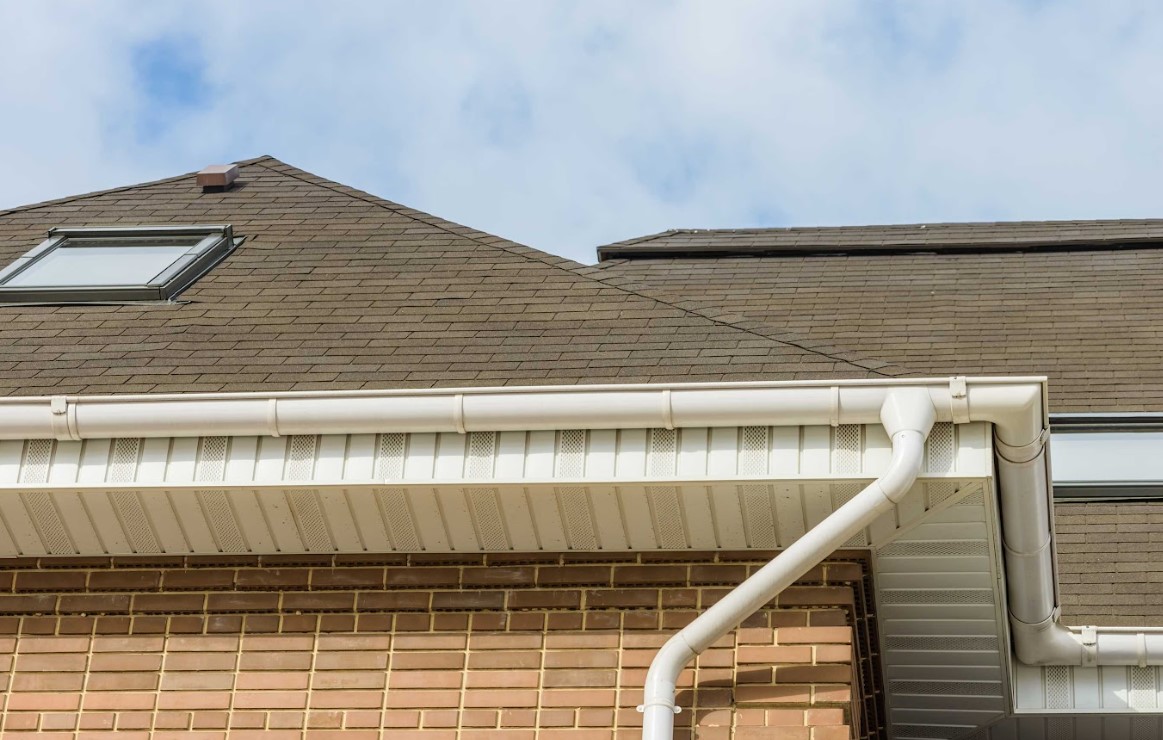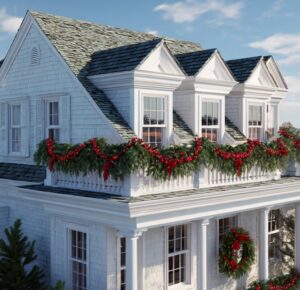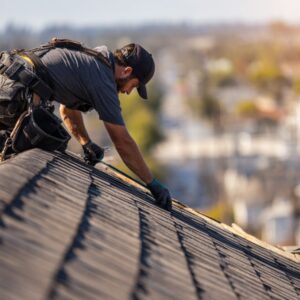Here’s the truth: Cold weather doesn’t care about your schedule.
One minute it’s 60 degrees and sunny, and the next, you’re scraping ice off your car and watching leaves pile up in your gutters like it’s their full-time job. That first real cold snap? It hits fast — and your roof and gutters better be ready when it does.
If you’ve lived in Albertson or anywhere on Long Island, you already know what winter brings: Wind. Ice. Snow. Freeze-thaw cycles.
And if your roofing or siding system has even one weak spot, this is when it’s going to show.
That’s where winterizing comes in.
Whether your home is brand new or pushing 100 years old, a few smart moves in the fall can save you thousands in water damage, siding repairs, or emergency roof fixes when it’s 25 degrees and blowing sideways.
This isn’t theory. This is exactly how we help homeowners across Long Island protect their roofs, gutters, and siding systems before winter shows up.
In this post, we’ll break down:
- What winterizing your roof and gutters really means (no fluff)
- What steps we recommend based on decades of local experience
- Materials that actually hold up in Long Island winters
- What to look for — and what to fix — before the snow hits
Want help getting it done right the first time? Rebuild America can help.
Why Every Long Island Home Needs a Winter Roofing and Gutter Game Plan
Let’s call it like it is: Long Island winters are hard on homes.
From mid-November through March, your house gets hit with:
- Heavy wet snow
- Wild temperature swings
- High winds that test every shingle and piece of siding
- And ice — lots of it
This isn’t a one-time thing. These cycles repeat, again and again, for months. And the moment your roof or gutter system stops doing its job, water finds a way in.
If you’ve got older siding, cracked shingles, or clogged gutters, winter is when you’ll pay for it.
That’s why we recommend every homeowner in Albertson and the greater Long Island area build winter prep into their fall routine.
What You Need to Know Before Winterizing Your Roof and Gutters
Let’s make sure you’re set up for success before the ladder comes out.
Budget What You Need — Avoid What You Don’t
- Roof and gutter inspection: $250–$450
- Gutter cleaning: $200 and up
- Flashing repairs, sealing, or minor fixes: $350–$1,500
We’re not about selling services you don’t need. But skipping this stuff? That’s how people end up with $5,000 in ceiling repairs by February.
Permits and Local Codes
- Basic repairs and cleanings: No permit required
- Full roof or siding replacements: Permit required in North Hempstead and most of Nassau County
Rebuild America handles all local permits and approvals for our clients — no guesswork.
Tools for the Job (if You DIY)
If you’re planning to tackle some of this yourself:
- Sturdy ladder
- Gutter scoop or blower attachment
- Roofing-grade sealant
- Flashlight for attic inspections
- Gloves, boots, and safety harness
For most homeowners, though, hiring a licensed Long Island roofing and siding team saves time, stress, and risk.
How to Winterize Your Roof and Gutters: Step-by-Step
Here’s our go-to winter prep process — the same one we use for homes across Long Island.
Step 1: Clean Gutters and Downspouts
Clogged gutters are a disaster waiting to happen. Once leaves get wet and freeze, they trap standing water, which backs up under shingles or overflows down siding.
Flush them out, top to bottom. Clean the channels, inspect the joints, and make sure water has a place to go.

Step 2: Inspect Shingles, Flashing, and Seams
Your roof doesn’t need to look bad to be vulnerable. One lifted shingle or a cracked seal around a vent is all it takes.
Focus on:
- Valleys
- Roof edges
- Chimneys
- Skylights
- Pipe boots
Not sure what you’re looking for? Book an inspection. We’ll find what you can’t see from the ground.
Step 3: Seal What Needs Sealing
Use a high-quality roofing sealant on:
- Exposed nails
- Loose flashing
- Pipe collars
- Small cracks in sealant lines
Winter wind, snowmelt, and freeze-thaw cycles will find any weak spot.
Step 4: Ventilation and Insulation Check
If your attic is too warm in the winter, you’ll melt the snow on your roof — which then freezes again at the eaves. That’s how ice dams form. And yes, they cause real damage.
Make sure:
- Your attic has airflow
- Soffit vents are unblocked
- Insulation is even and covers the entire ceiling plane
If you see frost, moisture, or signs of mold, it’s time for an attic upgrade.
Step 5: Secure Siding and Trim Back Trees
Wind gusts on Long Island rip siding off houses every year. Most of the time, it was already loose.
Check siding around windows, eaves, and corners. Snap it back in or call us to secure it. While you’re at it, cut back any tree branches that hang within 6 feet of your roof.
What Materials Actually Work in Long Island Winters
We’ve installed just about every kind of roofing and siding product out there. Some hold up. Some don’t. Here’s what we trust.
Want a full breakdown of the top roofing materials for cold weather?
Check out our in-depth guide on the best roofing materials for fall and winter in Long Island.
Roofing Materials We Recommend
- GAF Timberline HDZ shingles – Architectural shingles with high wind ratings and layered strength
- DaVinci synthetic slate – Engineered for freeze-thaw zones and harsh coastal weather
- GAF Liberty low-slope systems – Perfect for porches, dormers, and flat roof sections
- Ice & water shield underlayment – Mandatory for eaves, valleys, and anywhere water might pool
Siding That Can Take a Punch
- Hardie Board (fiber cement) – Moisture- and impact-resistant
- LP SmartSide – Engineered wood with treated layers
- Vinyl siding from Royal or Alside – Low-maintenance, affordable, and tough
If you’re not sure what you have on your home, we’ll check it during your inspection.
What Happens When You Skip Winterizing?
It’s not always immediate. But it always shows up.
Issue | What Happens | What It Costs |
Ice Dams | Water backs up under shingles | $2,000–$10,000 (interior repair) |
Frozen Gutters | Cracked fascia, siding damage | $800–$2,000 |
Roof Leaks | Mold, drywall damage | $500–$5,000 |
Siding Failures | Exposure to elements | $1,000–$4,000 |
And yes — most of these are preventable. We see it every year.
Common Winter Roofing and Gutter Questions from Long Island Homeowners
If you’re a homeowner in or near Long Island, and you’re trying to protect your home before winter hits, chances are you’ve got some questions. Below are the most common ones we hear from our clients this time of year — along with straightforward answers based on decades of hands-on experience in Long Island roofing and siding.
How often should I clean my gutters in the fall?
You should clean your gutters at least twice during the fall — once in mid-October and again after the last of the leaves come down. This helps prevent ice dams and overflow that can damage your roof and siding when freezing temperatures arrive.
What’s the best roofing material for winter in Long Island?
The best roofing material for Long Island winters is typically architectural asphalt shingles or synthetic slate, as they handle wind, moisture, and freeze-thaw cycles better than cheaper or older materials.
Can clogged gutters really damage my roof or siding?
Yes, clogged gutters can absolutely damage your roof and siding. Water backs up, freezes, and seeps into vulnerable areas — leading to rotted fascia, damaged shingles, and even foundation problems if left unchecked.
How can I tell if my attic is properly insulated and ventilated?
You can tell if your attic is properly insulated and ventilated by checking the temperature — your attic should be cold in the winter, not warm. A warm attic means poor ventilation, which can lead to ice dams, moisture buildup, and premature roof failure.
Will my insurance cover roof or gutter damage caused by winter weather?
Homeowners insurance may cover storm-related roof or gutter damage, but it usually won’t cover issues caused by a lack of maintenance — like clogged gutters or poor insulation. That’s why preventative winterizing is so important.
Who should I call for winter roof and siding prep in Albertson, NY?
You should call Rebuild America for winter roofing and siding services in Albertson and throughout Long Island. Our certified crews handle inspections, repairs, and full-service prep with decades of experience in this region’s unique weather conditions.
Final Takeaway: Don’t Wait for the First Freeze to Act
If your gutters are sagging, your attic’s warm, or you haven’t looked at your roof since spring — now is the time.
Winter is coming whether you’re ready or not. But prepping your roof and gutters doesn’t have to be overwhelming. It just has to get done.
At Rebuild America, we’ve been helping Long Island homeowners get through winter with fewer repairs and more peace of mind for generations. Whether it’s a quick inspection or a full roofing and siding upgrade, we’re ready to help.
Schedule your free inspection today, and start winter on the right foot.



